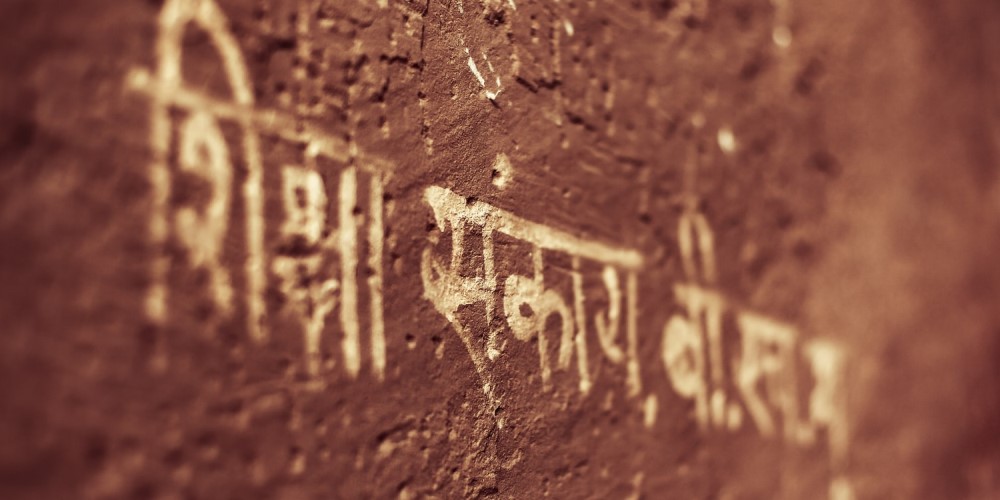Important Sanskrit Words in Buddhism: The Three Characteristics of Existence
If you are interested in any kind of Indian philosophy, Buddhist writings and Hinduism, it will not take long till you come across Sanskrit words. Anyone who begins to practice yoga will surely encounter OHM (the original voice), Nameste at the end of the lesson, closing mantras, and other Sanskrit words step by step.
These Sanskrit words and expressions cannot usually be translated into just one word. Behind certain Sanskrit words lies a much deeper meaning, even a whole philosophy.Their understanding requires a more thorough interpretation.
The word Sanskrit itself means “assembled, edited,” that is, it was not created by humans as natural languages, but by celestial beings of a higher level of consciousness than man. It is also the language of the oldest Indian philosophical writings, the Vedas and many Buddhist writings.
Let’s have a closer look at the three characteristics of existence according to Buddhist philosophy, namely suffering – the state of duḥkha, non-self – the state of anatta and the state of aniccsa – impermanence.
Duhkha – Suffering
In Buddha’s essential teaching, the Four Noble Truths, the existence of duḥkha represents the first noble truth. The circle of suffering or the noble truth of suffering. Life is inseparable from what is called duḥkha.
This Sanskrit word is often translated as suffering, but there is more to it. It means something more elementary, like pain and misfortune. It refers to a fundamental dissatisfaction that runs through the lives of all of us except the enlightened.
This dissatisfaction sometimes comes to the surface in the form of grief, pain, despair, or frustration, but for the most part it floats only on the edge of our consciousness as a vague and indefinable feeling that things are never really perfect, never fully meet our expectations.
According to Buddha, the presence of duḥkha is the only real spiritual, conscious problem.
In his teachings, he offers a method of how to get out of the cicrle of suffereing, the state of duhkha, and how to attain or dwell in the state of sukkha, that is joy. The Four Noble Truths are the teachings of the Buddha, which aim to silence the mind and bring it to a peaceful, meditative state.

Anattā – Non-Self
This term was mainly used by the Buddha to express that we all suffer from the experience, hearing, smell, touch, thinking, and attachment of our senses.
Things have no middle, no permanent core or essence. For example look at a thought: Where is the core? What is the middle and what is left of it? What is the core of a thought or an external voice? What is left of it? Nothing. In the same way, our ego and personality are not permanent, but an illusion. What we perceive as ourselves is a constantly flowing, swirling set of thoughts, imaginations, perceptions, body sensations, and emotions. These phenomena are constantly flowing in the space of our consciousness and we attribute them to ourselves.
If we consciously observe these phenomena in meditation, we will see that they do not exist. At their core, they are empty. They only seem so real because of the dependent origin. (For example, when we dream, the dream seems very real, and then we wake up and realize that we have dreamed)
It is a conditioned, that is “learned”, mixture of images, thoughts, and feelings of ourself, our ego.
For example, if we see the snow falling, it comes to our minds to put on a winter coat when we go out on the street. We learned what cold is and we also learned how to “react to it”. This whole series of thoughts works completely automatically when conditions appear, stimuli to which we have already learned to react.
All our actions depend on conditions, circumstances, mood, room, body position. We perceive this to be a stable system, but this is an illusion.
If we see things as they are, in the nature of emptiness, if a thought remains just a thought, not my thought, if a taste remains a taste, the attachment to things, the attachment to the Self, is already eased.
As the Buddha said, “What is transient, subject to change, suffering, and by nature such cannot be considered‘ I ’,‘ mine ’, or‘ myself ’. Whatever we consider as self will cause suffering ”(SN 22.59). The eternal happiness of the self is impossible.
Anitja or Anicca – Impermanence
Anitja, the last of the three characteristics of existence, means transience, the finite, transient nature of the things that arise. What started will end. What is born dies. This is one of the fundamental laws of natural existence on earth. We need to understand that all phenomena work this way, be it our bodies, our homes, our loved ones, our clothes. They all grow old, break up and die.
And this is not just about the physical plane. Our thoughts, our emotions, our states of consciousness are all transient. If we look at a picture of a thought, it pops up and appears after a few seconds. Feelings sometimes stay for a few seconds, maybe hours, then go away, transform.
The perception of spiritual experiences, visions, energies is also a kind of experience that rises and passes. We do not know a vision that remains there as a persistent image of man for, say, 20 years, every day, every hour. That is, on every plane of existence, all phenomena are transient, impermanent, and variable. This is what anitja or aniccsa (Paul) means.

Sukkha – Joy
The state of sukkha can be translated to a happy, good, joyful, glamorous, light, pleasant, soft, gentle, and virtuous state. Literally meaning ‘good place’ the suffix su means good and kha means place.
The term, according to the original explanation, means a journey in which we travel in a well-balanced chair with wheels, making our journey easy and smooth, making it feel like it is a state full of movement. It is dominated by momentum, movement and flow. It includes action without the will-to-do, states of effortless effort.
The Depth in the Meaning of Sanskrit Words
You can see that some Sanskrit words, and especially the Buddhism’s three characteristics of existence, cannot be described by a single word. Just as the Indian Vedas which are an integalr part of the Upanishads and Buddhist philosophy.
Perhaps with this new understanding of Sanskrit words that the three characteristics of existence, you will also get a deeper understanding of your yoga practice in one of the best yoga studios in Budapest.
 English
English magyar
magyar